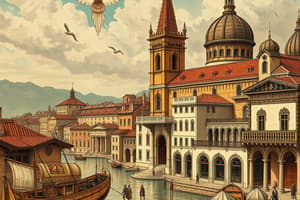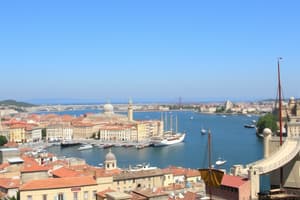Podcast
Questions and Answers
What luxury item was rare in Europe before the Crusades?
What luxury item was rare in Europe before the Crusades?
- Sugar (correct)
- Silk
- Perfumes
- Spices
Why were Eastern goods expensive in Europe?
Why were Eastern goods expensive in Europe?
- Because of the long and arduous transportation route (correct)
- Due to the high cost of production
- Because of trade restrictions
- Due to high demand
What did European consumers and distributors want to find?
What did European consumers and distributors want to find?
- A way to decrease demand
- A more expensive route to Asia
- A way to monopolize the market
- A cheaper route to Asia (correct)
Who returned to Europe in 1295 and sparked further interest in Eastern luxuries?
Who returned to Europe in 1295 and sparked further interest in Eastern luxuries?
What was the primary motivation for Europeans to explore alternative trade routes?
What was the primary motivation for Europeans to explore alternative trade routes?
What regions were involved in the transportation of Eastern goods to Europe?
What regions were involved in the transportation of Eastern goods to Europe?
What was the indirect result of the book written by the discoverer of the New World?
What was the indirect result of the book written by the discoverer of the New World?
What navigational challenge did European sailors face along the coast of West Africa?
What navigational challenge did European sailors face along the coast of West Africa?
What was the innovation that helped Portuguese mariners overcome the navigational challenge?
What was the innovation that helped Portuguese mariners overcome the navigational challenge?
What was the primary driving force behind the establishment of the modern plantation system?
What was the primary driving force behind the establishment of the modern plantation system?
What region of Africa was known to Europe since antiquity?
What region of Africa was known to Europe since antiquity?
Which of the following best describes the impact of the plantation economy on the New World?
Which of the following best describes the impact of the plantation economy on the New World?
What was the barrier that separated the northern and southern regions of Africa?
What was the barrier that separated the northern and southern regions of Africa?
What was the consequence of Portuguese mariners overcoming the navigational challenges?
What was the consequence of Portuguese mariners overcoming the navigational challenges?
What was the primary motivation behind the Portuguese exploration of Africa?
What was the primary motivation behind the Portuguese exploration of Africa?
What was the significance of Bartholomeu Días' journey in 1488?
What was the significance of Bartholomeu Días' journey in 1488?
What was the impact of the early trade routes on European understanding of goods from the East?
What was the impact of the early trade routes on European understanding of goods from the East?
Approximately how many Africans were taken to the Atlantic sugar islands in the last half of the fifteenth century?
Approximately how many Africans were taken to the Atlantic sugar islands in the last half of the fifteenth century?
Study Notes
Crusades and Luxury Goods
- Silk was a rare luxury item in Europe before the Crusades.
- Eastern goods were expensive due to long trade routes and high demand among European consumers.
European Interest in Eastern Luxuries
- European consumers and distributors sought to find direct access to Eastern luxuries like spices, silks, and precious stones.
- Marco Polo returned to Europe in 1295, reigniting interest in Eastern goods and travel narratives.
Exploration Motivations
- The primary motivation for exploring alternative trade routes was to bypass intermediaries, reducing costs and increasing profit margins.
- Regions involved in transporting Eastern goods included the Middle East, North Africa, and parts of Asia.
Impact of Exploration Narratives
- The indirect result of Columbus's discoveries was a heightened European curiosity about Eastern luxuries and new trade opportunities.
Navigational Challenges in West Africa
- European sailors faced treacherous currents, uncharted waters, and dangerous coastal conditions along the West African coast.
- The caravel, a new sailing ship design, allowed Portuguese mariners to navigate these challenges effectively.
Economic Developments
- The establishment of the modern plantation system was primarily driven by the demand for sugar, leading to an increase in slave labor.
- The coastal region of West Africa had been known and interacted with by Europeans since antiquity, mainly for trade.
Plantation Economy in the New World
- The plantation economy significantly impacted the New World through the establishment of agricultural production models that relied heavily on slave labor.
Geographic and Historical Barriers
- The Sahara Desert served as a natural barrier separating the northern and southern regions of Africa.
- Overcoming navigational challenges allowed for increased maritime trade, expansion of European influence, and colonization efforts.
Portuguese Exploration Consequences
- The primary motivation behind Portuguese exploration of Africa was to secure trade routes and access to gold and spices.
- Bartholomeu Días' journey in 1488 was significant as it marked the first European navigation around the southern tip of Africa, opening sea routes to India.
Understanding Trade Routes
- Early trade routes enhanced European understanding of Eastern goods, shaping demand and paving the way for future explorations and colonization.
Atlantic Slave Trade
- Approximately 30,000 Africans were taken to the Atlantic sugar islands in the last half of the fifteenth century, establishing a brutal cycle of slave labor for sugar production.
Studying That Suits You
Use AI to generate personalized quizzes and flashcards to suit your learning preferences.
Description
Discover how the Crusades influenced European trade, sparking a desire for exotic goods like silk, spices, and sugar. Learn about the luxury goods that became coveted in Europe and their significant impact on world history.




